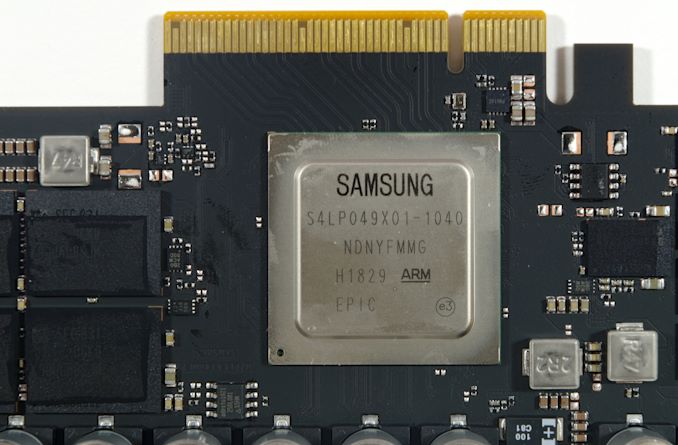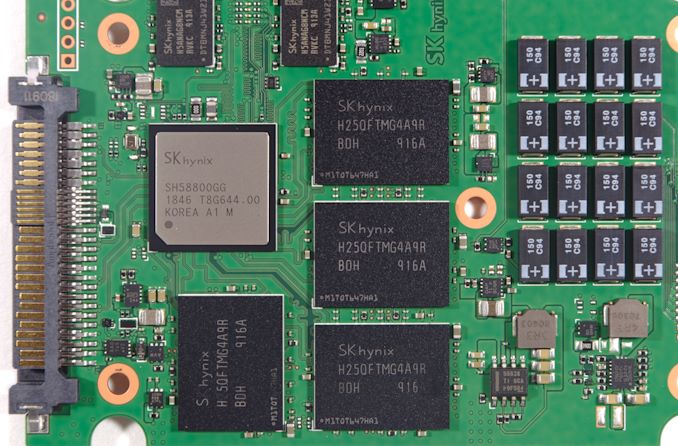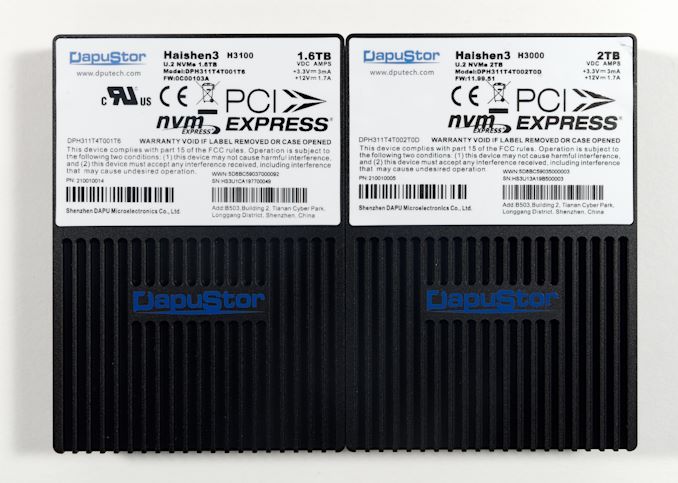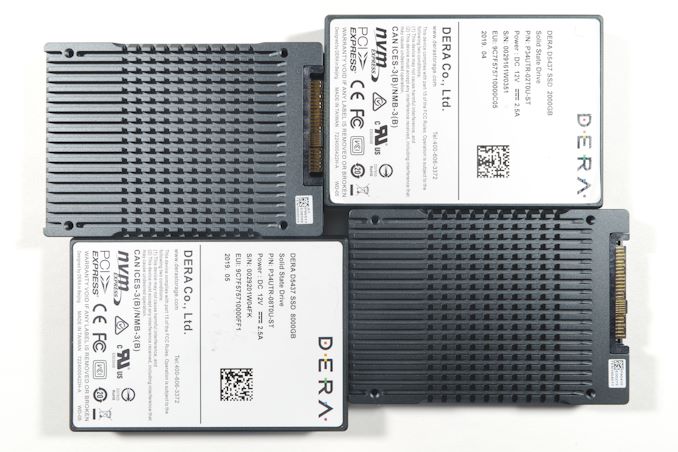Enterprise NVMe Round-Up 2: SK Hynix, Samsung, DapuStor and DERA
by Billy Tallis on February 14, 2020 11:15 AM ESTConclusion
Testing nine new drives drives at once makes it tricky to summarize the results with just a few conclusions. Each of the four manufacturers represented in this review are in very different situations requiring different strategies. In turn, the SSDs we've tested all have their own strengths and weaknesses. Since we're unable to offer real insight on how affordable these drives are to the large business customers they are primarily aimed at, we'll focus more on the tech itself.
The Samsung PM1725a is strictly speaking outdated, having been succeeded by a PM1725b with newer 3D NAND and a PM1735 with PCIe 4.0. But it's still a flagship model from the top SSD manufacturer, and we don't get to test those very often. Despite being two generations old, the PM1725a still holds some advantages over the latest and greatest from lower product segments. It has easily the highest read performance of any single SSD we can get our hands on, including the ability to deliver over 1000000 random read IOPS. It's fast enough that most software cannot even come close to fully using its performance potential. The PM1725a also carries a higher write endurance rating than most recent high-end models. However, its actual write performance is not the highest we've seen, and the older NAND and controller mean it sometimes struggles to match the latency of newer drives. The sheer scale of the drive also somewhat limits its usability—not every server can accommodate and make productive use of a drive that is this powerful. On the other hand, the fact that MyDigitalDiscount is currently selling a limited stock of them at consumer SSD pricing means a lot of customers can try out this class of drive for the first time.
The SK Hynix PE6011 targets the most mainstream parts of the datacenter market: high density, manageably low power, 1 DWPD endurance and a performance profile suited for mostly read-oriented workloads. They didn't skimp on capacity, offering up to 7.68TB in a 2.5"/7mm U.2 drive. This kind of drive can't hope to beat the big high-end drives on performance, but it may offer better value. It seems like the biggest challenge for SK Hynix right now is the NAND flash itself. The 72L TLC used in the PE6011 is their first generation of 3D NAND that's remotely competitive, but they have yet to truly get ahead of the rest of the industry despite constantly aiming for the highest layer counts. This 3D TLC seems to be a bit slower than what the other drives are working with, and that cannot be entirely overcome by close cooperation between their NAND, controller and firmware teams. However, they have managed to put together a drive that's decent all around, with no really serious deficiencies. All this drive needs to find success in the market is competitive pricing.
DapuStor's Haishen3 H3000 and H3100 drives have similar aims to the SK Hynix PE6011 and PE6031. The Haishen3 drives use a thicker U.2 form factor but cover pretty much the same capacity range and aim for similar performance and power levels. DapuStor's marketing has a particular focus on their drives' power efficiency, and for good reason: the Hashien3 drives are often far more efficient than the competitors we have tested. A lot of this is probably due to the component selection. With Kioxia 96L TLC NAND, these drives are at least a generation ahead of everything else in this review, and the choice of a Marvell controller seems to have worked out well. The performance of the Haishen3 drives is a bit more hit-and-miss than the SK Hynix PE6011. The Haishen3 is usually a little bit faster than the PE6011 for throughput, but its latency and QoS vary from well ahead to far behind the competition depending on the workload. Between the read oriented H3000 and the H3100 for mixed workloads, these drives have a lot of potential use cases, and the great power efficiency could lead to some real TCO advantages.
DERA's D5437 and D5457 have enough performance to be serious contenders in the high-end enterprise SSD market. Their in-house 16-channel TAI controller might not be quite as powerful or efficient as those from Samsung and Microchip/Microsemi, but it comes close enough - especially taking into account that the controller is a few years old at this point, and about due for a PCIe 4.0 update. It's not hard to see how they've scored major customers at home. Like DapuStor, DERA still has a fairly narrow product line, but they probably have the resources to diversify into other market segments without too much trouble. The big challenges for DERA are probably the relatively non-technical ones: dealing with the geopolitics of being part of the Tsinghua family of companies while trying to sell abroad (especially in the US). They probably won't be able to differentiate their products with the promised benefits of YMTC NAND flash any time soon, so they still need to cultivate a close relationship with one of the incumbent NAND manufacturers (currently Intel).














33 Comments
View All Comments
Billy Tallis - Friday, February 14, 2020 - link
Me, too. It's a pity that we'll probably never see the Micron X100 out in the open, but I'm hopeful about Intel Alder Stream.I do find it interesting how Optane doesn't even come close to offering the highest throughput (sequential reads or writes or random reads), but its performance varies so little with workload that it excels in all the corner cases where flash fails.
curufinwewins - Friday, February 14, 2020 - link
Absolutely. It's so completely counter to the reliance on massive parallelization and over provisioning/cache to hide the inherent weaknesses of flash that I just can't help but being excited about what is actually possible with it.extide - Friday, February 14, 2020 - link
And honestly most of those corner cases are far more important/common in real world workloads. Mixed read/write, and low QD random reads are hugely important and in those two metrics it annihilates the rest of the drives.PandaBear - Friday, February 14, 2020 - link
Throughput has alot to do with how many dies you can run in parallel, and since optane has a much lower density (therefore more expensive and lower capacity), they don't have as many dies on the same drive, and that's why peak throughput will not be similar to the monsters out there with 128-256 dies on the same drive. They make it back in other spec of course, and therefore demand a premium for that.swarm3d - Monday, February 17, 2020 - link
Sequential read/write speed is highly overrated. Random reads and writes make up the majority of a typical workload for most people, though sequential reads will benefit things like game load times and possibly video edit rendering (if processing isn't a bottleneck, which is usually is).Put another way, if sequential read/write speed was important, tape drives would probably be the dominant storage tech by now.
PandaBear - Friday, February 14, 2020 - link
Some info from the industry is that AWS is internally designing their own SSD and the 2nd generation is based off the same Zao architecture and 96 layer Kioxia NAND that DapuStor makes. For this reason it is likely that it will be a baseline benchmark for most ESSD out there (i.e. you have to be better than that or we can make it cheaper). Samsung is always going to be the powerhouse because they can afford to make a massive controller with so much more circuits that would be too expensive for others. SK Hynix's strategy is to make an expensive controller so they can make money back from the NAND. Dera and DapuStor will likely only focus in China and Africa like their Huawei pal. Micron has a bad reputation as an ESSD vendor and they ended up firing their whole Tidal System team after Sanjay joined, and Sanjay pouched a bunch of WD/SanDisk people to rebuild the whole group from ground up.eek2121 - Friday, February 14, 2020 - link
I wish higher capacity SSDs were available for consumers. Yes, there are only a small minority of us, but I would gladly purchase a high performance 16TB SSD.I suspect the m.2 form factor is imperfect for high density solid state storage, however. Between heat issues (my 2 TB 970 EVO has hit 88C in rare cases...with a heatsink. My other 960 EVO without a heatsink has gotten even hotter.) and the lack of physical space for NAND, we will likely have to come up with another solution if capacities are to go up.
Billy Tallis - Friday, February 14, 2020 - link
Going beyond M.2 for the sake of higher capacity consumer storage would only happen if it becomes significantly cheaper to make SSDs with more than 64 NAND dies, which is currently 4TB for TLC. Per-die capacity is going up slowly over time, but fast enough to keep up with consumer storage needs. In order for the consumer market to shift toward drives with way more than 64 NAND dies, we would need to see per-wafer costs drop dramatically, and that's just not going to happen.Hul8 - Saturday, February 15, 2020 - link
I think the number of consumers both interested in 6GB+ *and* able to afford them are so few, SSD manufacturers figure they can just go buy enterprise stuff.Hul8 - Saturday, February 15, 2020 - link
*6TB+, obviously... :-D